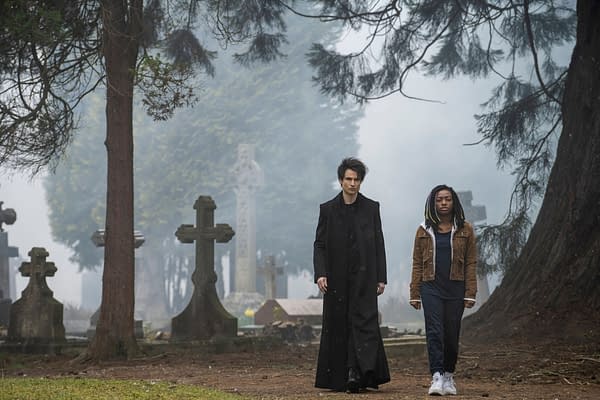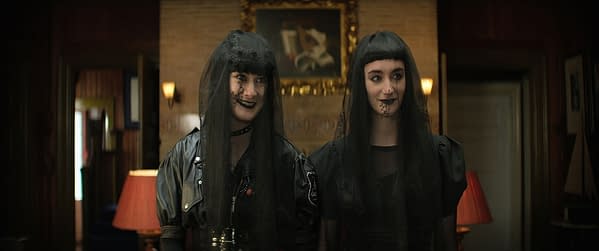Posted in: Netflix, TV | Tagged: neil gaiman, netflix, The Sandman, Tom Sturridge
The Sandman S01E07 "A Doll's House": Changes from Comics-to-Screen
The sixth episode of Netflix's The Sandman could be called a mid-season break with Dream (Tom Sturridge) succeeding in retrieving his tools and regaining his kingdom. Now the season is in its home stretch with four episodes to go, adapting "The Doll's House" story arc. While it faithfully follows the main plot points of the comic story, some of the most significant changes are also in this arc, starting with episode seven.

A Different, More Proactive Rose Walker for The Sandman
For starters, we're presented with Rose Walker's (Vanessa Samunyai) backstory, where she's separated from her brother Jed in their parents' bitter divorce, which was not depicted in the comics. This is an immediate screenwriting setup that establishes Rose's drive to find her brother after years of separation. Rose is different from the Rose of the comic, who was more of a stereotypical moody, self-preoccupied, and privileged teenager-turned-21. The Rose of the TV series doesn't have a personality but a strong goal: to find her brother. That makes her a proactive second protagonist for the show. Unlike the Rose of the comics, she's actively searching, calling on all the resources she has. While her mother in the comics was a slightly scatty but well-meaning lady, her mother in the show has passed away and given her their house so she can have a home.

A Different Lyta Hall who's Not an Ex-Superhero
Another big change is Lyta Hall (Razanne Jammal). Here she's not a former superhero and hinted-at daughter of the Earth-2 Golden Age Wonder Woman. She's a middle-class architect mourning the recent death of her husband Hector (Lloyd Everitt). Hector Hall is not the son of the Golden Age Hawkman but just a guy who appears in his wife's dreams, and not the 1970s superhero version of The Sandman created by Jack Kirby. She and Hector are friends of Rose, who became her surrogate parents in her teens, whereas Rose never meets Lyta in the comics. In the comics, Lyta is a disillusioned superhero and passive. The Lyta of the show is assertive and actively supports Rose in her quest. She accompanies Rose in her mother's stead to England to meet her long-lost great-grandmother Unity Kincaid (Sandra James-Young). Since The Sandman TV series is set in 2022, an entire generation has passed since 1989, so Rose is Unity's great-granddaughter rather than her granddaughter. As in the comics, Unity woke from her sleeping sickness, inherited her family's money, and hired investigators to track down her remaining family.
A Past Pandemic to Mirror Our Current One
By the way, there really was a pandemic of sleeping sickness in real life in 1916. 500,000 people died without waking up. Its medical term was "Encephalitis Lethargica," as Unity mentions, and Its cause was never truly explained. The assumption was that it was a viral or bacterial, or parasitic infection. Neil Gaiman used the common convention in Fantasy and Horror fiction to create a supernatural explanation for a historical event. You could draw an analogy between that pandemic and the one we all just lived through, with Unity as a recent survivor. The emotional reunion of family members after a long period of separation is also a theme strongly felt by the British through Lockdown, and The Sandman being a largely British show, seems to allude to that.
"The Sandman" TV Show is Paced Differently from the Comics
The first half of the episode adapts The Sandman #11, introducing Rose, establishing her world, and meeting Unity. Rose meets the three ladies of the Fates in a broom closet, and their forewarning of events about to hit her is largely from the comic. Meanwhile, Dream and Lucienne (Vivienne Acheampong) state his arc for the rest of the season: finding three runaway dreams: Fiddler's Green, Gault, and the Corinthian, who is also searching for Rose. Dream and Lucienne also identify Rose as a Vortex, which is why she's important to the story. The serial killers trying to plan their convention are also brought forward in the show to set up where all the storylines will converge. Jed (Eddie Karanja) is also introduced trying to run away from abuse by his abusive foster father, with the equally abused wife (Daisy Head) trying and failing to protect him. Jed's dreams will be revealed in a later episode in a way different from the comics.

As with The Sandman #12, Unity funds Rose's search for Jed, which leads to Rose moving into a guest house in Florida where Jed's last known address is. Rose's housemates are a faithful recreation of the characters from the comic, though the Ken half (Richard Fleeshman) of the Ken & Barbie couple is a dark-haired dudebro hipster with a man-bun instead of a bland, blond jock, which undercuts the "Ken & Barbie" joke from the comic. The Addams Family-esque goth ladies Chantal and Zelda (Cara Horgan and Daisy Badger) are recruited intact from the comic as landlord and drag artist Hal (John Cameron Mitchell). The series also shows its first slip-up in its diverse casting – they're in Florida, yet there are no Latino actors or characters. This blindspot might be partly because the show was largely shot in the UK, and there are hardly any Latino or Hispanic actors there, but their absence in the Florida scenes stands out.
The Corinthian and his Serial Killer Fanclub
Episode 7 also brings in the serial killers trying to organise a convention earlier than in the comics. There's a darkly comedic and satirical tone to their scenes here as it sets up the serial killer convention that's going to be the climax of the Corinthian's arc later. The Corinthian (Boyd Holbrook) appears in this episode to remind us he's still a menace and Big Bad of the season. however, the show doesn't cut to the scenes from the comic of the Corinthian stalking and torturing his victims from his point of view, which was a trope from the 70s and 80s horror movies and might also be an homage to the Giallo movies of Dario Argento, who pioneered the baroque POV sequences of serial killings. We already know the Corinthian is a serial killer, and he's more actively searching for Rose as part of his agenda to thwart Dream.
Setting Up Like a New Season Premiere
This episode feels like the start of a new season in the way it spends the hour setting up a new cast of characters and throwing all the balls of plot in the air that will be spinning out for the next three episodes. The final change in the show is to have Rose meet Dream face-to-face early on so she can ask for his help finding Jed, which sets them up as active co-leads for the rest of the season instead of Dream being a casual, passive observer of events until the story's climax. Movies and television demand that the protagonist of a story takes an active role in the story to make the audience care, and this is how the writers handily solve that issue in The Sandman. Introducing the other plot threads early is also a television convention of setting up and foreshadowing where the rest of the season is headed, so it feels less random than the comics. After all, writers love foreshadowing, and foreshadowing is almost the entirety of The Sandman series. They manage to get away with Rose having no personality because there's so much going on, and she has a goal to work for. Her tragic family history and need to find her lost brother make her immediately sympathetic, and orphans searching for a lost family is a common plot in Fantasies and fairy tales, and The Sandman is precisely both.












